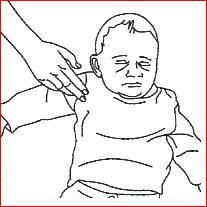Time Required : CPR should start as soon as possible! You can save lives within 10 minutes.
There is no substitute for learning Cardiopulmonary resuscitation (CPR). CPR is a skill we’ll never be called upon to use, but it may be the most valuable skill anyone could have.
Here’s How:
1. Stay safe! The worst thing a rescuer can do is become another victim. Follow universal precautions and wear personal protective equipment if you have it. Use common sense and stay away from potential hazards.
2. Attempt to wake victim. Briskly rub your knuckles against victim’s sternum. If the victim does not wake, call 991 and proceed to step 3. If the victim does not wake, moans, or moves, then CPR is not necessary at this time. Call 991 if the victim is confused or not able to speak.
3. Begin rescue breathing. Open the victim’s airway using the head-tilt, chin-lift method.
4. Put your ear to the victim’s open mouth:
- look for chest movement
- listen for air flowing through the mouth or nose
- feel for air on your cheek
If there is no breathing, pinch the victim’s nose; make a seal over the victim’s mouth with yours. Use a CPR mask if available. Give the victim a breath big enough to make the chest rise. Let the chest fall then repeat the rescue breath once more.
5. Begin chest compressions. Place the heel of your hand in the middle of the victim’s chest. Put your other hand on top of the first with your fingers interlaced. Compress the chest about 4 – 5 cm. Allow the chest to completely recoil before the next compression.
6. Repeat rescue breaths. Open the airway with head-tilt, chin-lift again. This time, go
7. Perform 30 more chest compressions. Repeat steps 5 and 6 for about two minutes.
8. Stops compressions and recheck victim for breathing. If the victim is not breathing, continue chest compressions and rescue breaths.
9. Keep going until help arrives.
Tips:
1. If you have access to an automated external defibrillator, attach it to the victim after approximately one minute of CPR (chest compressions and rescue breaths).
2. Chest compressions are extremely important and help maintain some blood flow to the lungs, brain, coronary arteries, and other major organs. If you are not comfortable giving rescue breaths, continue to perform chest compressions!
3. It’s normal to feel pops and snaps when you first begin chest compressions – DON’T STOP! You aren’t going to make the victim any worse. Cardiac arrest is as bad as it gets.
4. When performing chest compressions, do not let your hands bounce. Let the chest fully recoil, but keep the heel of your hand in contact with the sternum at all times.
1. Shout and Tap: shout and gently tap the child on the shoulder
2. Open The Airway: Open the airway using a head tilt lifting of chin. Do not tilt the head too far back.
3. Give 2 Gentle Breaths: If the baby is NOT breathing, give 2 small gentle breaths. Cover the baby’s mouth and nose with your mouth. Each breath should be 1 second long. You should see the baby’s chest rise with each breath.
4. Give 30 Compressions: Give 30 gentle chest compressions at the rate of 100 per minute. Use two or three fingers in the center of the chest just below the nipples. Press down approximately one-third the depth of the chest.
5. Repeat: Repeat with 2 breath and 30 compressions. After two minutes of repeated cycles call 991 (or your local emergency number) and continue giving breaths and compressions.
Warning: Do not attempt to do the CPR if you are not well-trained. Check your local CPR practitioner to know further.


















 Keadaan dalam khemah perubatan/kecemasan
Keadaan dalam khemah perubatan/kecemasan 






